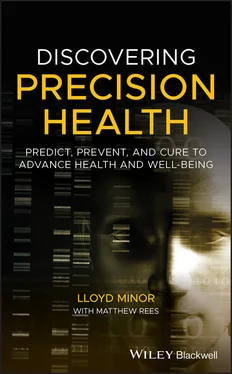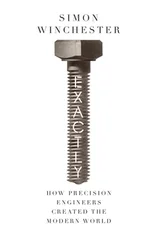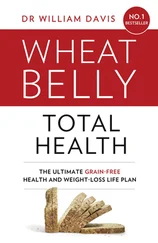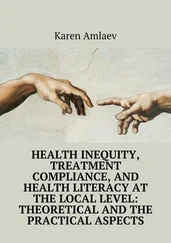It has also been reaffirming to see that several other institutions have recently adopted Precision Health as a strategic theme. These include Cedars‐Sinai, Geisinger Health System, Indiana University, UCLA, the University of Chicago, the University of Michigan, and the University of Texas.
I was determined to write this book to provide an overview of the Precision Health vision. But I also wanted to help reorient how health and medicine are viewed in the United States, and even throughout the world. While you’ll see that Stanford professors feature prominently, as do several companies operating near Stanford, the vision I’m putting forward is universally applicable. My inclusion of the companies is intended to provide an overview of the wide‐ranging approaches and technologies that have the goal of improving health and health care. This overview of commercial activity is not intended to be comprehensive, nor does the inclusion of a company in any way reflect an endorsement of its approach or likelihood of success [19].
Virtually any institution, or any individual, can embrace the tenets of Precision Health and begin working toward achieving better health outcomes. And all communities—regardless of income levels and ethnic, racial, or religious composition—can benefit from Precision Health. Indeed, while Silicon Valley is seen as a cradle of wealth, it’s also home to several jurisdictions where incomes are well below the national average, and where public health indicators paint a picture of distress. We are working in these communities with as much or more determination as we are in other communities with wealthier and healthier profiles.
To showcase the importance of Precision Health, chapter 1is devoted to the state of health in the United States, as well as the health care delivery system. While there are gains to report on both fronts, it’s also clear that there’s considerable room for improvement and reform. In chapter 2, I address a fact that gets overlooked in most discussions of health: medical care plays only a small role in determining our health outcomes. Much more important are environmental, social, and behavioral factors, and I explore some of the reasons why they have been so difficult to address and why I believe components of Precision Health, such as the revolution in digital health, offer promising new hope.
Progress in medicine is enabled by pushing the bounds of conventional thinking in pursuit of a better way of treating diseases and other medical conditions. Chapter 3features some of the innovations and disruptions—past, present, and hopefully future—found across health and medicine. I also describe the environments that are most likely to give rise to innovation.
In chapter 4, I focus on the importance of basic science and its role in discovery. As much as we know about the human body and how it functions, we get daily reminders that there is still much more to learn. Only by advancing our understanding will it be possible to develop the therapies that can improve health and well‐being. In this chapter I profile several trailblazers whose breakthroughs rest on a foundation of basic science.
The chapters that follow are dedicated to the three main pillars of Precision Health. In chapter 5, I discuss the many different ways in which it’s possible to preemptively identify deviations in health that may become debilitating, which makes it possible for individuals—acting alone and/or with health care professionals—to focus on interventions that will increase the likelihood of staying healthy. In chapter 6, I show how a range of tools—from smartphone technology to genome sequencing—are helping to avert illness and promote health and wellness. In chapter 7, I document a range of breakthroughs—particularly in the cancer field—that are being applied to help people recover from illness or disease. In the conclusion, I look at how health and medicine have evolved over the past century and how they may continue to evolve in the future.
For anyone with an interest in issues related to health and medicine, this is an exciting moment. We are learning more and more about what contributes to human health, and the different ways in which individuals can empower themselves to lead healthier lives. We are on the brink of an amazing transformation in the practice of medicine.
I hope this book will help you understand the dynamic future that lies ahead. I also hope it will inspire you to work with others—whether family, friends, or your broader community—to help ensure that the Precision Health vision can become a reality for people in the United States and throughout the world.
CHAPTER 1 THE STATE OF U.S. HEALTH AND HEALTH CARE DELIVERY
One of the motivations for launching Precision Health was to confront an uncomfortable reality: in the United States, there’s a lot about health conditions, and our health care system, that’s unsatisfactory. To be sure, the United States can be the very best place in the world to obtain the latest, most scientifically advanced treatments for severe diseases for those who have access to these services. But there are dramatic disparities in health and in access to high‐quality health care, based on factors such as income and geography. There are also shortcomings embedded in the U.S. health care system, which is one reason why we spend more on health care, on a per‐capita basis, than any other country, but our health indicators (such as life expectancy) put us on par with countries that spend less— much less. In this chapter, I examine both U.S. health conditions and U.S. health care, and show how millions of Americans are not seeing the health benefits that are typically associated with living in a high‐income country such as the United States.
Health conditions in the United States are heavily bifurcated, with certain segments of the population seeing great progress while others see their health eroding.
The backdrop to the progress is the revolution in health that’s unfolding, with much of it happening in and around Silicon Valley. It’s clear that we’re living in a time of unprecedented possibilities, with new knowledge and technologies accelerating the pace of biomedical discovery. In the area of biomedicine, there’s a convergence of different fields and ideas and approaches underway.
One small but revealing symbol of the potential for progress is the research being conducted by Stanford faculty. Approximately two‐thirds of the professors in the chemistry department are doing biologically focused research. So are about 30 percent of those in Stanford’s engineering school. Several factors account for this shift in focus to research questions and opportunities in biomedicine by experts in other disciplines. The fields of biology and medicine have become quantitative endeavors. Gone are the days when the scientific inquiry in biomedicine was driven principally by qualitative description. The same analytical methods and approaches that have fueled advances in the physical sciences and technology for many decades are now being applied with enormous success in biomedicine. The questions being addressed and the discoveries being made, thanks to these quantitative approaches, are having a tremendous impact.
There are many examples of the transformation in biomedicine that is occurring because of the adoption of quantitative approaches. Mapping of the human genome and the subsequent advances in sequencing technology have changed the landscape of genetics. These advances—exciting as they are—increasingly seem modest compared with the impact of more sophisticated algorithms focused on identification of the relationships between the genome and diseases as well as the interactions between the genome and other nongenetic risk factors for disease. These same transformations are having an impact on fundamental, discovery‐focused science.
Читать дальше












